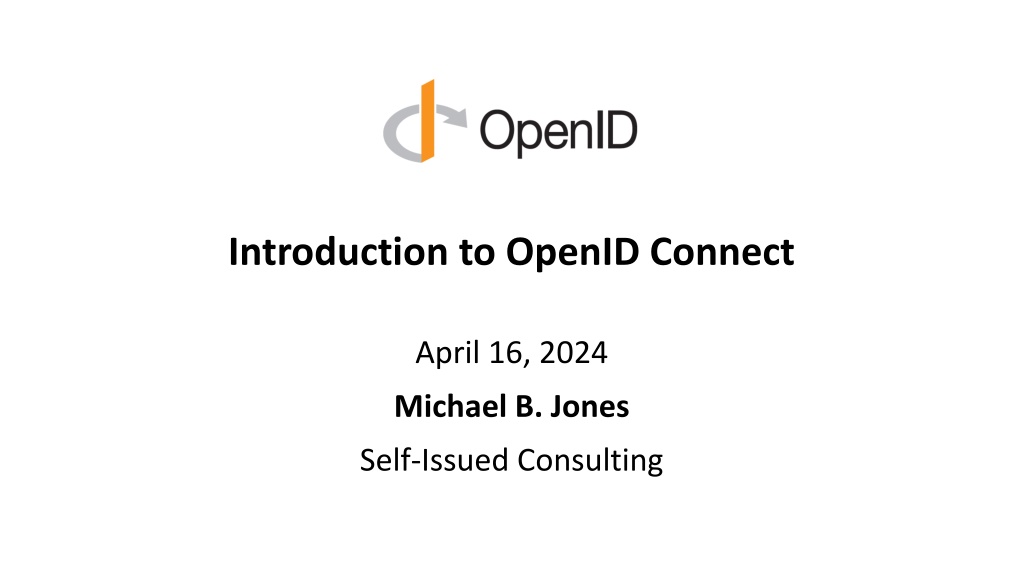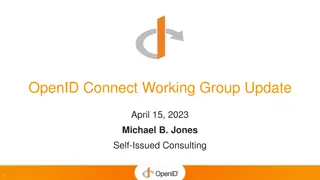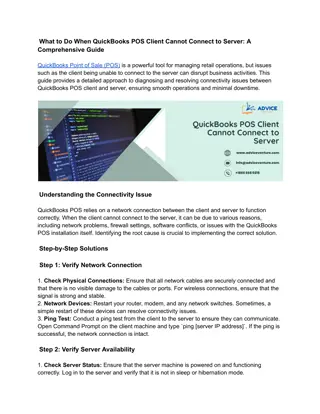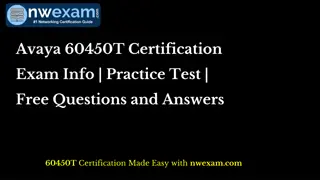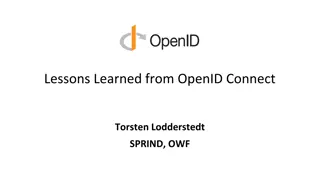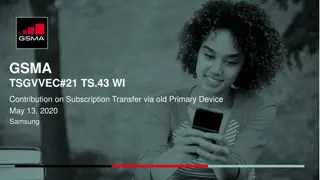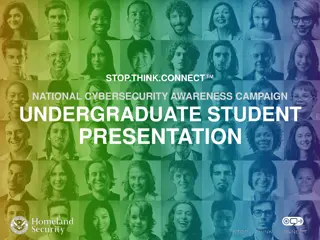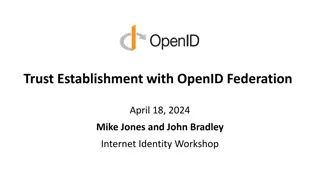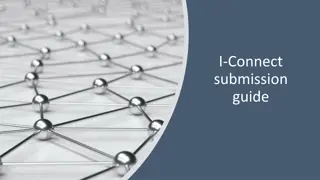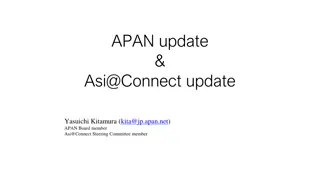Understanding OpenID Connect: A Comprehensive Overview
OpenID Connect is a simple identity layer built on top of OAuth 2.0, enabling reliable verification of end-user identities and access to basic profile information. Widely used by major companies and across various industries, OpenID Connect offers a range of use cases and security options, making it a versatile and essential part of modern digital interactions. Explore its design philosophy, implementation scenarios, and the accolades it has received for innovation and standards compliance.
Download Presentation

Please find below an Image/Link to download the presentation.
The content on the website is provided AS IS for your information and personal use only. It may not be sold, licensed, or shared on other websites without obtaining consent from the author. Download presentation by click this link. If you encounter any issues during the download, it is possible that the publisher has removed the file from their server.
E N D
Presentation Transcript
Introduction to OpenID Connect April 16, 2024 Michael B. Jones Self-Issued Consulting
Working Together OpenID Connect
What is OpenID Connect? Simple identity layer on top of OAuth 2.0 Enables Relying Parties (RPs) to verify identity of end-user Enables RPs to obtain basic profile info REST/JSON interfaces low barrier to entry Described at https://openid.net/connect/
Youre Almost Certainly Using OpenID Connect! Android, AOL, Apple, AT&T, Auth0, Deutsche Telekom, ForgeRock, Google, GrabTaxi, GSMA Mobile Connect, IBM, KDDI, Microsoft, NEC, NRI, NTT, Okta, Oracle, Orange, Ping Identity, Red Hat, Salesforce, Softbank, Symantec, Telef nica, Verizon, Yahoo, Yahoo! Japan, all use OpenID Connect Many other sites and apps large and small use OpenID Connect OpenID Connect is infrastructure Not a consumer brand
OpenID Connect Range Spans use cases, scenarios Internet, Enterprise, Mobile, Cloud, Federated, User-Centric Spans security & privacy requirements From non-sensitive information to highly secure Spans sophistication of claims usage From basic default claims to specific requested claims to collecting claims in multiple formats from multiple sources Maximizes simplicity of implementations Uses existing IETF specs: OAuth 2.0, JSON Web Token (JWT), etc. Lets you build only the pieces you need
Numerous Awards OpenID Connect won 2012 European Identity Award for Best Innovation/New Standard https://openid.net/2012/04/18/openid-connect- wins-2012-european-identity-and-cloud-award/ OAuth 2.0 won in 2013 JSON Web Token (JWT) & JOSE won in 2014 OpenID Certification program won 2018 Identity Innovation Award OpenID Certification program won 2018 European Identity Award
Presentation Overview Introduction Design Philosophy Timeline A Look Under the Covers Overview of OpenID Connect Specs More OpenID Connect Specs OpenID Certification Resources
Design Philosophy Keep Simple Things Simple Make Complex Things Possible
Keep Simple Things Simple UserInfo Endpoint for simple claims about user Designed to work well on mobile phones
How We Made It Simple Built on OAuth 2.0 Uses JavaScript Object Notation (JSON) Lets you build only the pieces that you need Goal: Easy implementation on all modern development platforms
Make Complex Things Possible Encrypted Claims Aggregated Claims Distributed Claims
Key Differences from OpenID 2.0 Support for native client applications Identifiers using e-mail address format UserInfo Endpoint for simple claims about user Designed to work well on mobile phones Uses JSON/REST, rather than XML Support for encryption and higher LOAs Support for distributed and aggregated claims Support for session management, including logout Support for self-issued identity providers
OpenID Connect Timeline Artifact Binding working group formed, March 2010 Major design issues closed at IIW, May 2011 Result branded OpenID Connect 5 rounds of interop testing between 2011 and 2013 Specifications refined after each round of interop testing Won Best New Standard award at EIC, April 2012 Final specifications approved, February 2014 Errata Set 1 approved, November 2014 OpenID Connect Certification launched, April 2015 OpenID Federation work begun, July 2016 OpenID Certification program won awards in March 2018 and April 2018 Logout specifications became Final, September 2022 Numerous extension specs under way, including for Verifiable Credentials, 2019-present Errata Set 2 approved, December 2023 OpenID Connect submitted to ISO for publication as PAS specifications, January 2024
A Look Under the Covers ID Token Claims Requests UserInfo Claims Example Protocol Messages
ID Token JSON Web Token (JWT) representing logged-in session Claims: iss Issuer sub Identifier for subject (user) aud Audience for ID Token iat Time token was issued exp Expiration time nonce Mitigates replay attacks
ID Token Claims Example { "iss": "https://server.example.com", "sub": "248289761001", "aud": "0acf77d4-b486-4c99-bd76-074ed6a64ddf", "iat": 1311280970, "exp": 1311281970, "nonce": "n-0S6_WzA2Mj" }
Claims Requests Basic requests made using OAuth scopes: openid Declares request is for OpenID Connect profile Requests default profile info email Requests email address & verification status address Requests postal address phone Requests phone number & verification status offline_access Requests Refresh Token issuance Requests for individual claims can be made using JSON claims request parameter
UserInfo Claims sub name given_name family_name middle_name nickname preferred_username profile picture website gender birthdate locale zoneinfo updated_at email email_verified phone_number phone_number_verified address
UserInfo Response Example { "sub": "248289761001", "name": "Jane Doe", "given_name": "Jane", "family_name": "Doe", "email": "janedoe@example.com", "email_verified": true, "picture": "https://example.com/janedoe/me.jpg" }
Authorization Request Example https://server.example.com/authorize ?response_type=id_token%20token &client_id=0acf77d4-b486-4c99-bd76-074ed6a64ddf &redirect_uri=https%3A%2F%2Fclient.example.com%2Fcb &scope=openid%20profile &state=af0ifjsldkj &nonce=n-0S6_WzA2Mj
Authorization Response Example HTTP/1.1 302 Found Location: https://client.example.com/cb #access_token=mF_9.B5f-4.1JqM &token_type=bearer &id_token=eyJhbGzI1NiJ9.eyJz9Glnw9J.F9-V4IvQ0Z &expires_in=3600 &state=af0ifjsldkj
UserInfo Request Example GET /userinfo HTTP/1.1 Host: server.example.com Authorization: Bearer mF_9.B5f-4.1JqM
OpenID 2.0 to OpenID Connect Migration (Additional Final Specification) Defines how to migrate from OpenID 2.0 to OpenID Connect Has OpenID Connect identity provider also return OpenID 2.0 identifier, enabling account migration https://openid.net/specs/openid-connect-migration-1_0.html Completed April 2015 Google shut down OpenID 2.0 support in April 2015 AOL, Yahoo, others have replaced OpenID 2.0 with OpenID Connect
OAuth 2.0 Form Post Response Mode (Additional Final Specification) Defines how to return OAuth 2.0 Authorization Response parameters (including OpenID Connect Authentication Response parameters) using HTML form values auto-submitted by the User Agent using HTTP POST A form post binding, like SAML and WS-Federation An alternative to fragment encoding https://openid.net/specs/oauth-v2-form-post-response-mode- 1_0.html Completed April 2015 In production use by Microsoft, Ping Identity
RP-Initiated Logout Enables RP to request that OP log out end-user https://openid.net/specs/openid-connect-rpinitiated-1_0.html Content recently split out of Session Management spec Can be used with all OP-Initiated Logout methods Not affected by browser privacy changes (unlike some of the OP-Initiated Logout methods) Final Specification as of September 2022
OP-Initiated Logout Enables OP to request that RPs log out end-user s sessions with the OP Three approaches specified by the working group: Session Management https://openid.net/specs/openid-connect-session-1_0.html Uses HTML5 postMessage to communicate state changes between OP and RP iframes Front-Channel Logout https://openid.net/specs/openid-connect-frontchannel-1_0.html Uses HTTP GET to load image or iframe, triggering logout (similar to SAML, WS-Federation) Back-Channel Logout https://openid.net/specs/openid-connect-backchannel-1_0.html Server-to-communication not using the browser (so can be used by native applications) All support multiple logged-in sessions from OP at RP Session Management & Front-Channel Logout affected by browser privacy changes Final Specifications as of September 2022
unmet_authentication_requirements Specification OpenID Connect Core Error Code unmet_authentication_requirements https://openid.net/specs/openid-connect-unmet-authentication-requirements-1_0.html Defines unmet_authentication_requirements error code Enables OP to signal that it failed to authenticate the End-User per the RP s requirements Became Final in November 2022
prompt=create Specification Initiating User Registration via OpenID Connect specification https://openid.net/specs/openid-connect-prompt-create-1_0.html Requests enabling account creation during authentication Became Final in December 2022
Tenth Anniversary of OpenID Connect OpenID Connect specifications were approved in February 2014 Three celebrations are being held January 2024 at Japan OpenID Summit in Tokyo May 2024 at Identiverse in Las Vegas June 2024 at EIC in Berlin Presentations from first celebration published at https://self-issued.info/?p=2481 During the celebrations, we are sharing our perspectives on How we developed OpenID Connect Why it succeeded Lessons we learned along the way Lessons learned Keep simple things simple Repeated interop testing and incorporating resulting feedback from developers was critical Certification enables an ecosystem of interoperable implementations
Exciting time for OpenID Connect! More happening than at any time since original specs created I ll give you a taste of the exciting work happening
OpenID Federation Specification OpenID Federation specification https://openid.net/specs/openid-federation-1_0.html Enables trust establishment and maintenance of multi-party federations Applying lessons learned from large-scale SAML federations Can be used for OpenID Connect, OAuth 2.0 deployments Recently renamed from OpenID Connect Federation to reflect broader role Can be and is used both with and without OpenID Connect Defines hierarchical JSON-based metadata structures for participants Three interop events were held in 2020 In production use in Italy, Australia, Sweden Have already resolved most open issues Last Implementer s Draft planned in this quarter Then advancement to Final status later this year
OpenID for Verifiable Credentials Family of three specs enabling use of identities that you hold Uses the three-party Issuer/Holder/Verifier model An Issuer creates a Verifiable Credential for you to hold You hold it in a Wallet You present it to a Verifier Credential format agnostic Can be used w/ W3C VCs, ISO Mobile Driving Licenses (mDL), SD-JWTs, etc. Has good privacy properties Issuer doesn t know when/where you re using the credential See https://openid.net/openid4vc/
OpenID for Verifiable Credential Issuance OpenID for Verifiable Credential Issuance specification https://openid.net/specs/openid-4-verifiable-credential-issuance-1_0.html Specifies how to issue Verifiable Credentials to Holder/Wallet Based on OAuth 2.0 Credential format agnostic For example, can use with ISO Mobile Driving Licenses (mDL) Includes issuer-initiated flow First Implementer s Draft approved this month
OpenID for Verifiable Presentations OpenID for Verifiable Presentations specification https://openid.net/specs/openid-4-verifiable-presentations-1_0.html Defines how to present Verifiable Presentations to a Verifier Based on OAuth 2.0 Credential format agnostic For example, can use with ISO Mobile Driving Licenses (mDL) Second Implementer s Draft approved May 2023 Actively working towards third Implementer s Draft
Self-Issued OpenID Provider V2 OpenID Connect Core defined Self-Issued OpenID Provider (SIOP) functionality Lets you be your own identity provider (rather than a third party) Self-Issued OpenID Provider v2 specification https://openid.net/specs/openid-connect-self-issued-v2-1_0.html Extends initial SIOP functionality to include DIDs as subjects Credential format agnostic SIOP being used with ISO Mobile Driving Licenses (mDL) Implementer s Draft approved February 2022 Actively working towards second Implementer s Draft
Native SSO Specification OpenID Connect Native SSO for Mobile Apps specification https://openid.net/specs/openid-connect-native-sso-1_0.html Enables Single Sign-On across apps by the same vendor Assigns a device secret issued by the Authorization Server Deployed by AOL Became an Implementer s Draft in December 2022
Second Errata Set Edits were performed to address outstanding errata issues Updates to Core, Discovery, Registration, and Backchannel Logout Errata updates do not change the meaning of the specs Second Errata Set published December 2023
ISO Publicly Available Submission (PAS) for OpenID Connect Submission of OpenID Connect specs for republication by ISO/IEC JTC 1 Will enable use of OpenID Connect in jurisdictions requiring specs by treaty organizations Submission accepted, January 2024 No changes were made to the submitted specifications, other than adding ISO title pages ISO spec numbers assigned, February 2024 ISO/IEC CD 26131: Information technology OpenID Connect Core 1.0 ISO/IEC CD 26132: Information technology OpenID Connect Discovery 1.0 ISO/IEC CD 26133: Information technology OpenID Connect Dynamic Client Registration 1.0 ISO/IEC CD 26134: Information technology OpenID Connect RP-Initiated Logout 1.0 ISO/IEC CD 26135: Information technology OpenID Connect Session Management 1.0 ISO/IEC CD 26136: Information technology OpenID Connect Front-Channel Logout 1.0 ISO/IEC CD 26137: Information technology OpenID Connect Back-Channel Logout 1.0 ISO/IEC CD 26138: Information technology OAuth 2.0 Multiple Response Type Encoding Practices ISO/IEC CD 26139: Information technology OAuth 2.0 Form Post Response Mode Publication as ISO specs expected after five-month ISO balloting period
Related OpenID Working Groups Mobile Operator Discovery, Registration, & autheNticAtion (MODRNA) Mobile operator profiles for OpenID Connect Financial-grade API (FAPI) FAPI used for Open Finance in jurisdictions including UK, Australia, Brazil, Saudia Arabia, Norway, Germany, Japan, Canada, & more to come eKYC and Identity Assurance (eKYC-IDA) Defines JWT format for verified claims with identity assurance information Digital Credentials Protocols (DCP) Future home of OpenID for Verifiable Credentials (OpenID4VC) specifications
Identity Assurance Specification (Related Work in eKYC-IDA WG) OpenID Connect for Identity Assurance https://openid.net/specs/openid-connect-4-identity-assurance-1_0.html JWT representation for verified person data Including information about the identity verification performed Enables legal compliance for some use cases Moved to eKYC and Identity Assurance working group in 2019 Fourth Implementer s Draft approved October 2022
CIBA Core (Related Work in MODRNA WG) OpenID Connect Client-Initiated Backchannel Authentication (CIBA) Core https://openid.net/specs/openid-client-initiated-backchannel- authentication-core-1_0.html Authentication flow with direct Relying Party to OpenID Provider communication without redirects through browser Used by FAPI CIBA Profile Became Final in September 2021
What is OpenID Certification? Enables OpenID Connect (and FAPI) implementations to be certified as meeting the requirements of defined conformance profiles Goal is to make high-quality, secure, interoperable implementations the norm An OpenID Certification has two components: Technical evidence of conformance resulting from testing Legal statement of conformance Certified implementations can use the OpenID Certified logo 3,532 total certifications to date!
What value does certification provide? Technical: Certification testing gives confidence that things will just work No custom code required to integrate with implementation Better for all parties Relying parties explicitly asking identity providers to get certified Business: Enhances reputation of organization and implementation Shows that organization is taking interop seriously Customers may choose certified implementations over others
OpenID Connect Certification Profiles Authentication Basic Flow Implicit Flows Hybrid Flows Third Party-Initiated Login Flow Discovery (OP Metadata) Dynamic Client Registration Logout RP-Initiated Logout Session Management Front-Channel Logout Back-Channel Logout Form Post Response Mode
OpenID Connect OP Certifications OpenID Provider certifications at https://openid.net/certification/#OPs 616 profiles certified to date for 160 deployments Recent additions: Duende Software, MonoCloud, Myself, SAP, Scrive AB, Tiago Cardoso Each entry link to zip file with test logs and signed legal statement Test results available for public inspection
OpenID Connect RP Certifications Relying Party certifications at https://openid.net/certification/#RPs 127 profiles certified to date for 43 deployments Recent additions: Echoworx, Erlang Ecosystem Foundation, Filip Skokan
Use of Self-Certification OpenID Certification uses self-certification Party seeking certification does the testing (rather than paying a 3rd party to do the testing) Simpler, quicker, less expensive, more scalable than 3rd party certification Results are nonetheless trustworthy because Testing logs are made available for public scrutiny Organization puts its reputation on the line by making a public declaration that its implementation conforms to the profile being certified to
How does OpenID Certification work? Organization decides what profiles it wants to certify to For instance, Basic OP , Config OP , and Dynamic OP Runs conformance tests publicly available at https://www.certification.openid.net/ Once all tests for a profile pass, organization submits certification request to OpenID Foundation containing: Logs from all tests for the profile Signed legal declaration that implementation conforms to the profile Organization pays certification fee (for profiles not in pilot mode) OpenID Foundation verifies application is complete and grants certification OIDF lists certification at https://openid.net/certification/
What does certification cost? Not a profit center for the OpenID Foundation Fees there to help cover costs of operating certification program Member price $700 Non-member price $3500 New profiles in pilot mode are available to members for free Costs described at https://openid.net/certification/fees/
